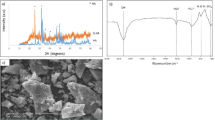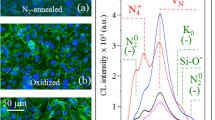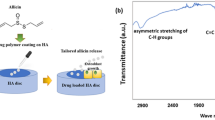Abstract
Silicon is an essential element for healthy bone development and supplementation with its bioavailable form (silicic acid) leads to enhancement of osteogenesis both in vivo and in vitro. Porous silicon (pSi) is a novel material with emerging applications in opto-electronics and drug delivery which dissolves to yield silicic acid as the sole degradation product, allowing the specific importance of soluble silicates for biomaterials to be investigated in isolation without the elution of other ionic species. Using polycaprolactone as a bioresorbable carrier for porous silicon microparticles, we found that composites containing pSi yielded more than twice the amount of bioavailable silicic acid than composites containing the same mass of 45S5 Bioglass. When incubated in a simulated body fluid, the addition of pSi to polycaprolactone significantly increased the deposition of calcium phosphate. Interestingly, the apatites formed had a Ca:P ratio directly proportional to the silicic acid concentration, indicating that silicon-substituted hydroxyapatites were being spontaneously formed as a first order reaction. Primary human osteoblasts cultured on the surface of the composite exhibited peak alkaline phosphatase activity at day 14, with a proportional relationship between pSi content and both osteoblast proliferation and collagen production over 4 weeks. Culturing the composite with J744A.1 murine macrophages demonstrated that porous silicon does not elicit an immune response and may even inhibit it. Porous silicon may therefore be an important next generation biomaterial with unique properties for applications in orthopaedic tissue engineering.





Similar content being viewed by others
References
Carlisle EM. Silicon as an essential element. Fed Proc. 1974;33:1758–66.
Carlisle EM. Silicon as a trace nutrient. Sci Total Environ. 1988;73:95–106.
Reffitt DM, Ogston N, Jugdaohsingh R, Cheung HFJ, Evans BAJ, Thompson RPH, Powell JJ, Hampson GN. Orthosilicic acid stimulates collagen type 1 synthesis and osteoblastic differentiation in human osteoblast-like cells in vitro. Bone. 2003;32:127–35.
Arumugam MQ, Ireland DC, Brooks RA, Rushton N, Bonfield W. Orthosilicic acid increases collagen type I mRNA expression in human bone-derived osteoblasts in vitro. Key Eng Mater. 2006;254:869–72.
Anderson SI, Downes S, Perry CC, Caballero AM. Evaluation of the osteoblast response to a silica gel in vitro. J Mater Sci Mater Med. 1998;9:731–5.
Xynos IE, Alasdair JE, Buttery LDK, Hench LL, Polak JM. Gene-expression profiling of human osteoblasts following treatment with the ionic products of Bioglass 45S5. J Biomed Mater Res. 2001;55:151–7.
Valerio P, Pereira MM, Goes AM, Leite MF. The effect of ionic products from bioactive glass dissolution on osteoblast proliferation and collagen production. Biomaterials. 2004;25:2941–8.
Sripanyakorn S, Jugdaohsingh R, Thompson RPH, Powell JJ. Dietary silicon and bone health. Nutr Bull. 2005;30:222–30.
Jugdaohsingh R, Tucker KL, Qiao N, Cupples LA, Kiel DP, Powell JJ. Dietary silicon intake is positively associated with bone mineral density in men and premenopausal women of the Framingham Offspring cohort. J Bone Miner Res. 2004;19:297–307.
Hench LL. The story of Bioglass®. J Mater Sci. 2006;17:967–78.
Canham T. Bioactive silicon fabrication via nanoetching techniques. Adv Mater. 1995;7:1033–7.
Anglin EJ, Cheng L, Freeman WR, Sailor MJ. Porous silicon in drug delivery devices and materials. Adv Drug Deliv Rev. 2008;60:1266–77.
Serda RE, Gu J, Bhavane RC, Liu X, Chiappini C, Decuzzi P, Ferrari M. The association of silicon microparticles with endothelial cells in drug delivery to the vasculature. Biomaterials. 2009;30:2440–8.
Zhang K, Loong SL, Connor S, Yu SW, Tan SY, Ng RT, Lee KM, Canham L, Chow PK. Complete tumor response following intratumoral 32P BioSilicon on human hepatocellular and pancreatic carcinoma xenografts in nude mice. Clin Cancer Res. 2005;11:7532–7.
Park JH, Gui L, Malzahn G, Ruoslahti E, Bhatia SN, Sailor MJ. Biodegradable porous silicon nanoparticles for in vivo applications. Nat Mater. 2009;8:331–6.
Coffer JL, Montchamp JL, Aimone JB, Weis RP. Routes to calcifled porous silicon: implications for drug delivery and biosensing. Physica Status Solidi A. 2003;197:336–9.
Anglin EJ, Schwartz MP, Ng VP, Perelman LA, Sailor MJ. Engineering the chemistry and nanostructure of porous silicon Fabry–Pérot films for loading and release of a steroid. Langmuir. 2004;20:11264–9.
Charnay C, Begu S, Tourne-Peteilh C, Nicole L, Lerner DA, Devoisselle JM. Inclusion of ibuprofen in mesoporous templated silica: drug loading and release property. Eur J Pharm Biopharm. 2004;57:533–40.
Vaccari L, Canton D, Zaffaroni N, Villa R, Tormen M, di Fabrizio E. Porous silicon as drug carrier for controlled delivery of doxorubicin anticancer agent. Microelectron Eng. 2006;83:1598–601.
Salonen J, Kaukonen AM, Hirvonen J, Lehto V-P. Mesoporous silicon in drug delivery applications. J Pharm Sci. 2008;97:632–53.
Whitehead MA, Fan D, Mukherjee P, Akkaraju GR, Canham LT, Coffer JL. High-porosity poly(epsilon-caprolactone)/mesoporous silicon scaffolds: calcium phosphate deposition and biological response to bone precursor cells. Tissue Eng Part A. 2008;14:195–206.
Johansson F, Kanje M, Linsmeier CE, Wallman L. The influence of porous silicon on axonal outgrowth in vitro. IEEE Trans Biomed Eng. 2008;55:1447–9.
Alvarez SD, Derfus AM, Schwartz MP, Bhatia SN, Sailor MJ. The compatibility of hepatocytes with chemically modified porous silicon with reference to in vitro biosensors. Biomaterials. 2008;30:26–34.
Dash TK, Konkimalla VB. Poly-E-caprolactone based formulations for drug delivery and tissue engineering: a review. J Control Release. 2012;158:15–33.
Sinha VR, Trehan A. Development, characterization, and evaluation of ketorolac tromethamine-loaded biodegradable microspheres as a depot system for parenteral delivery. Drug Deliv. 2008;15:365–72.
Rohner D, Hutmacher DW, Cheng TK, Oberholzer M, Hammer B. In vivo efficacy of bone-marrow-coated polycaprolactone scaffolds for the reconstruction of orbital defects in the pig. J Biomed Mater Res B. 2003;66:574–80.
Halimaoui A. Porous silicon formation by anodization. In: Canham LT, editor. Properties of porous silicon. London: Institution of Engineering and Technology; 1997.
Kokubo T, Kushitani H, Sakka S, Kitsugi T, Yamamuro T. Solutions able to reproduce in vivo surface-structure changes in bioactive glass-ceramic A-W. Biomed Mater Res. 1990;24:721–34.
Chouzouri G, Xanthos M. In vitro bioactivity and degradation of polycaprolactone composites containing silicate fillers. Acta Biomater. 2007;3:745–56.
Venugopal JR, Low S, Choon AT, Kumar AB, Ramakrishna S. Nanobioengineered electrospun composite nanofibers and osteoblasts for bone regeneration. Artif Organs. 2008;32:388–97.
Porter AE, Patel N, Skepper JN, Best SM, Bonfield W. Comparison of in vivo dissolution processes in hydroxyapatite and silicon-substituted hydroxyapatite bioceramics. Biomaterials. 2003;24:4609–20.
Porter AE, Patel N, Skepper JN, Best SM, Bonfield W. Effect of sintered silicate-substituted hydroxyapatite on remodelling processes at the bone-implant interface. Biomaterials. 2004;25:3303–14.
Gibson IR, Best SM, Bonfield W. Effect of silicon substitution on the sintering and microstructure of hydroxyapatite. J Am Ceram Soc. 2002;85:2771–7.
Schwarz K. A bound form of silicon in glycosaminoglycans and polyuronides. Proc Natl Acad Sci. 1973;70:1608–12.
Kleveta G, Borzęcka K, Zdioruk M, Czerkies M, Kuberczyk H, Sybirna N, et al. LPS induces phosphorylation of actin-regulatory proteins leading to actin reassembly and macrophage motility. J Cell Biochem. 2012;113:80–92.
Scotchford CA, Garle MJ, Batchelor J, Bradley J, Grant DM. Use of a novel carbon fibre composite material for the femoral stem component of a THR system: in vitro biological assessment. Biomaterials. 2003;24:4871–9.
Keeting PE, Oursler MJ, Weigand KE, Bonde SK, Spelsberg TC, Riggs BL. Zeolite A increases proliferation, differentiation and transforming growth factor beta production in normal adult human osteoblast-like cells in vitro. J Bone Miner Res. 1992;7:1281–9.
Sammons RL, El Haj AJ, Marquis PM. Novel culture procedure permitting the synthesis of proteins by rat calvarial cells cultured on hydroxyapatite particles to be quantified. Biomaterials. 1994;15:536–42.
Homaeigohar SSh, Shokrgozar MA, Sadi AY, Khavandi A, Javadpour J, Hosseinalipour M. In vitro evaluation of biocompatibility of beta-tricalcium phosphate-reinforced high-density polyethylene; an orthopedic composite. J Biomed Mater Res A. 2005;75:14–22.
Kubo K, Tsukasa N, Uehara M, Izumi Y, Ogino M, Kitano M, Sueda T. Calcium and silicon from bioactive glass concerned with formation of nodules in periodontal-ligament fibroblasts in vitro. J Oral Rehabil. 1997;24:70–5.
Zhou H, Choong P, McCarthy R, Chou ST, Martin TJ, Ng KW. In situ hybridization to show sequential expression of osteoblast gene markers during bone formation in vivo. J Bone Miner Res. 1994;9:1489–99.
Author information
Authors and Affiliations
Corresponding author
Rights and permissions
About this article
Cite this article
Henstock, J.R., Ruktanonchai, U.R., Canham, L.T. et al. Porous silicon confers bioactivity to polycaprolactone composites in vitro. J Mater Sci: Mater Med 25, 1087–1097 (2014). https://doi.org/10.1007/s10856-014-5140-5
Received:
Accepted:
Published:
Issue Date:
DOI: https://doi.org/10.1007/s10856-014-5140-5




